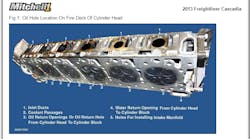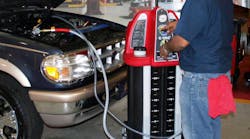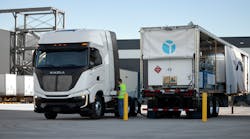Since the introduction of the latest American Petroleum Institute (API) CK-4 and FA-4 engine oil categories in 2016, heavy duty engine oils have received most of the attention when it comes to vehicle lubrication. However, there have been some significant developments with components behind the engine that are often overlooked when it comes to lubrication developments.
With a continuing focus on many factors impacting the transportation industry, including reducing greenhouse gas (GHG) emissions, improving fuel efficiency, finding solutions to truck driver shortages and reducing the total cost of vehicle operation, the introduction of the automated manual transmission and the new technology deserves some of that lubrication spotlight.
For decades, a large percentage of medium and heavy duty trucks have been equipped with manual transmissions requiring the use of a clutch and manually shifting gears. This type of transmission has served the industry well, but as it happens with other technology —like coffee percolators, bias ply tires and rotary telephones — there are new, more updated products available to replace it.
Today, a new concept in heavy duty transmissions has entered the industry with increasing popularity. By 2027, some predict that more than 90 percent of all medium and heavy duty trucks on the highway will have an automated manual transmission (AMT).
A review of transmission types
To better understand how these newer transmissions are impacting the industry, let’s review the transmission types used today. There are three basic types of heavy duty truck transmissions: fully automatic, manual and more recently, the automated manual transmissions.
AMTs provides several advantages compared to a manual transmission, including improved safety, reduced maintenance and improved fuel economy.
AMTs help improve safety by allowing greater focus on driving compared to the attention needed for the shifting of gears. This could result in less driver fatigue.
Reduced maintenance is achieved by not having as many manual transmission clutch repairs from improper shifting and overuse of the clutch brake.
The AMT computerized engine coordinated shifting contributes to improved fuel economy, with reported improvements of as much as 1.5 percent.
In this era of driver shortages, AMTs are more driver-friendly since the driver has less to manage during daily operations. The result of these advantages reduces the overall costs of operation and improves transportation efficiency.
Lower viscosity lubricants
Manufacturers of AMTs such as Eaton, Daimler, Paccar, Volvo and Mack Trucks have produced their own lubricant specifications matched to their transmission lubrication requirements. For many years, manual type transmissions have been lubricated with the equivalent of an SAE 50 viscosity oil.
A question that has often surfaced is, why does a manual transmission require a different type of lubricant from the axle or differential? This is best explained by simply saying that the transmission design is not compatible with the type of extreme pressure additives needed to protect the differential gears, which has resulted in two separate types of lubricant for the transmission axle or differentials.
With AMTs, the tradition continues of having a separate lubricant specification compared to the axle or differential. Even though some AMT lubricant products refer to their viscosity as SAE 75W-90 (according to the SAE J306 - gear oil - viscosity chart) and other lubricant products in the market list the viscosity as SAE 40 (according to SAE J300 - crankcase oil - viscosity chart). Either form of identification indicates that the new AMT type lubricants are of a lower viscosity than the preceding SAE 50 type lubricants. This lower viscosity contributes to the fuel economy gain overall.
Lubricant specification considerations for AMTs
Why do AMT manufacturers have different specifications and lubricant recommendations for their AMTs, and why can’t fleets continue to use the SAE 50 type lubricants in these new transmissions?
Below is a sample list of the lubricant specifications for AMTs by transmission manufacturer:
- Eaton: PS 386
- Daimler: Daimler DT12, and Mercedes MB 235.11
- Volvo: I Shift
- Mack Trucks: MACK M Drive
There are a number of considerations when it comes to the differences in these specifications, including:
- Lubricant specifications matched to transmission. The major AMT manufacturers have designed their transmission with specific lubrication requirements. It would be nice to have one product to work in all brands of transmissions, but to achieve optimum efficiency each manufacturer has matched the transmission with specific lubricant requirements and specifications. This helps ensure component warranty is covered and optimum performance is achieved.
- Fuel efficiency. As a strong point of emphasis, the new AMT lubricant products are rated as the viscosity equivalent of SAE 40 or SAE 75W-90 compared to the higher viscosity SAE 50 lubricants previously used in manual transmissions. The lower viscosity provides superior lubrication protection, resulting in improved fuel efficiency and improved cold startup lubrication that reduces energy losses and improves overall transmission efficiency.
- Extended warranty and lubricant service intervals. By using an AMT manufacturer’s approved lubricant, the fleet can take advantage of the manufacturer warranties and, in some cases, the extended lubricant service intervals. Always check with the manufacturer's recommendations for specific warranty and lubricant service interval information.
Conclusion
The departure from SAE 50 lubricant is in full force. With the continued adoption of AMTs, the demand for the new lubricants will increase significantly. Fleets are encouraged to take advantage of the new lubricant improvements, cost savings and operational efficiencies.
As the industry continues into the era of improving heavy duty trucking efficiency and lowering the cost of operation, the AMT and the performance matched high-performance lubricants represent another step in the direction of improving the transportation industry.
Mark Betner is the heavy duty sales manager for Citgo. He has 40 years of experience in the lubricants industry specializing in heavy equipment lubrication, and has been with Citgo for more than three decades. Betner holds a B.A. and master’s degree in chemistry and biological sciences. He is an active member of the Technology & Maintenance Council (TMC).






